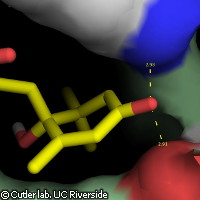Synthetic chemical helps defend crops against drought
A group of Canadian, Spanish and US researchers has shed light on what gives plants the boost they need to protect themselves against harsh weather conditions like drought. The results of their research, published in the journal Science, will help answer critical questions that have emerged over the years. Adverse environmental conditions wreak havoc with crops and other plants. Not only do crop yields shrink but farmers' wallets do as well. Plants are able to use specialised signals, the so-called 'stress hormones', to sense the hard times that lie ahead and adapt to the adverse conditions in order to increase their chances for survival. 'Plants have stress hormones that they produce naturally and that signal adverse conditions and help them adapt,' explained member of the team Professor Peter McCourt from the University of Toronto in Canada. 'If we can control these hormones we should be able to protect crops from adverse environmental conditions, which is very important in this day and age of global climate change.' Headed by Professor Sean Cutler of the University of California, Riverside in the US, the team identified 'abscisic acid' (ABA), the receptor of the key hormone, in stress protection. Plants boost their ABA levels when stress hits, effectively giving them the breathing room they need to survive a drought. Past studies have shown that ABA, which is produced naturally by plants, helps plants cope with drought conditions. And researchers had for years considered spraying ABA directly onto crops to boost their level of protection. However, not only is ABA a pricey and light-sensitive molecule, but scientists had not been able to find a niche for it in the agriculture sector. Until now, the process of how ABA works has not been well understood. The area of ABA receptors, according to the researchers, had triggered various debates in the field of plant biology. Numerous scientific papers have been retracted in recent times and many peers have questioned the publication of papers. Scientists recognise that the receptor, commonly found at the top of a signalling pathway, acts like a conductor leading a musical orchestra; the receptor relays orders to the team below who then carry through the specific decisions in the cell. 'Scientists have been trying to solve the ABA receptor problem for more than 20 years, and claims for ABA receptors are not easily received by the scientific community,' explained Professor Cutler. For this study, the researchers used a 'chemical genomics' approach so as to identify a synthetic chemical called 'pyrabactin' that specifically triggers an ABA receptor in the model laboratory plant Arabiodopsis. Thanks to pyrabactin, the researchers were able to identify the ABA receptor directly. 'This approach not only found a gene that had been long sought by the plant science research community, but it also showed that chemical genomics can identify new chemicals like pyrabactin that may have profound impacts on the way we farm in both the developing and developed world,' said Professor McCourt. Professor Cutler and his collaborator, Professor Brian Volkman from the Medical College of Wisconsin in the US, plan to deduce the structure of the receptor-bound ABA and use this information to guide the design of new chemicals able to activate the ABA signalling pathway.
Countries
Spain



